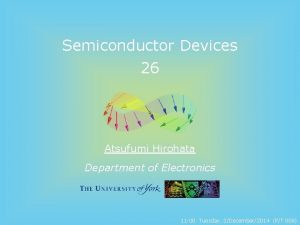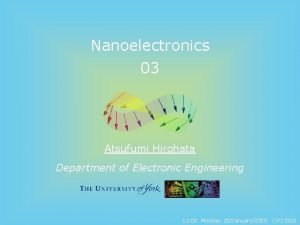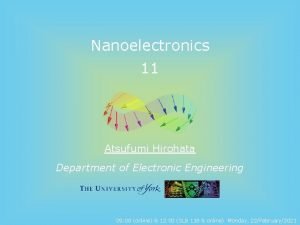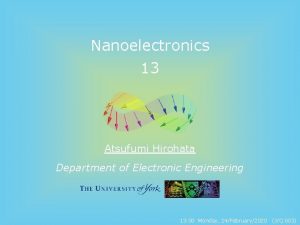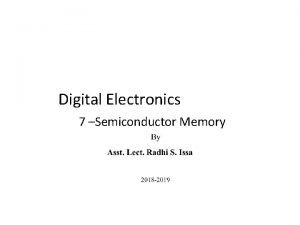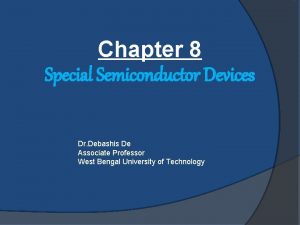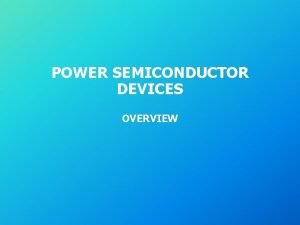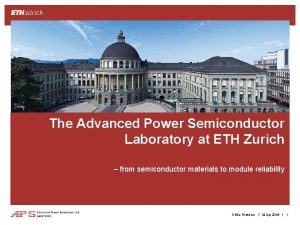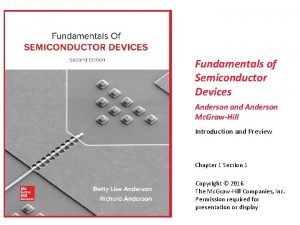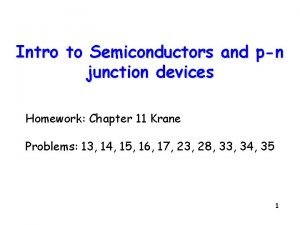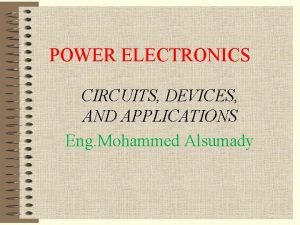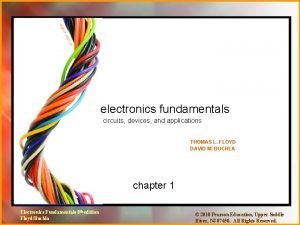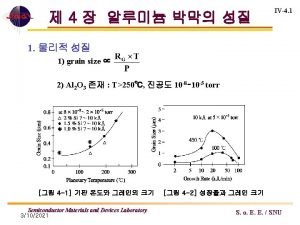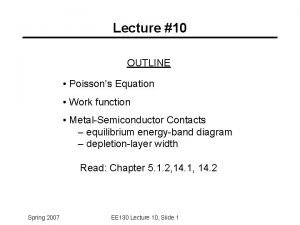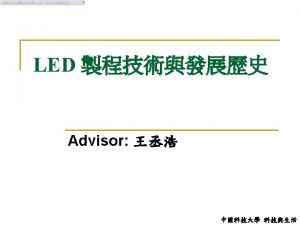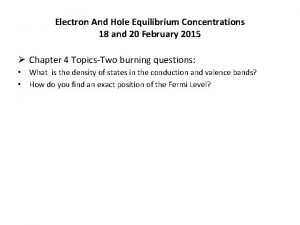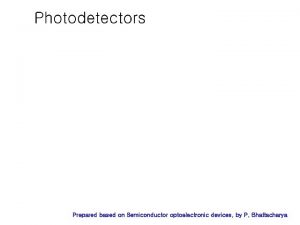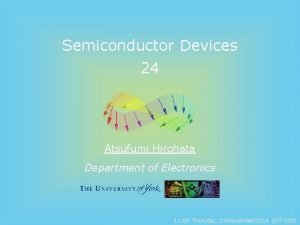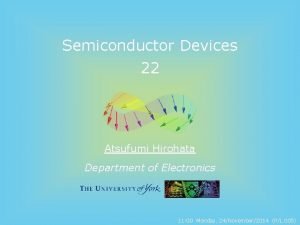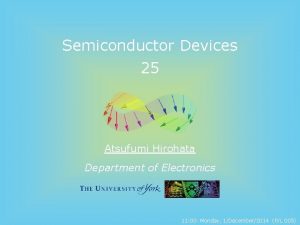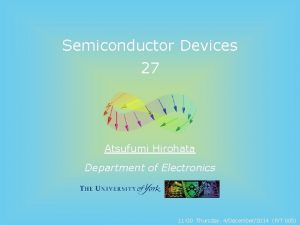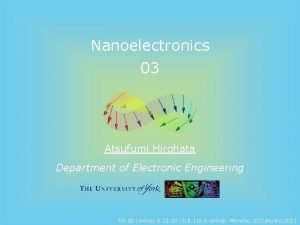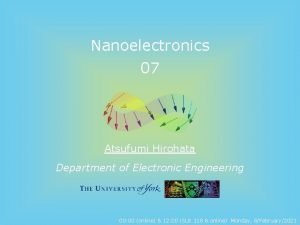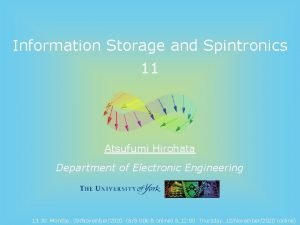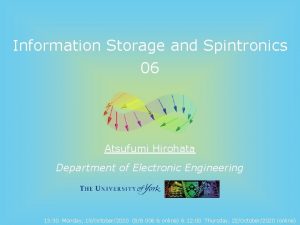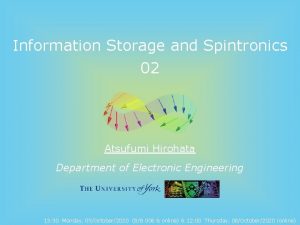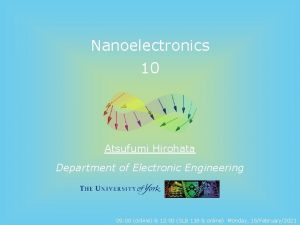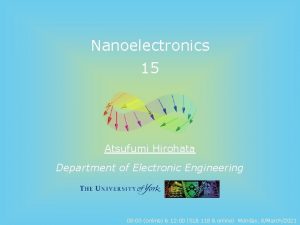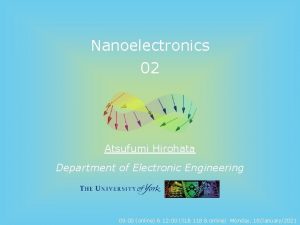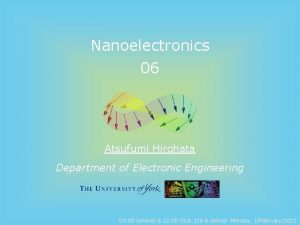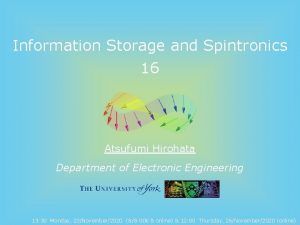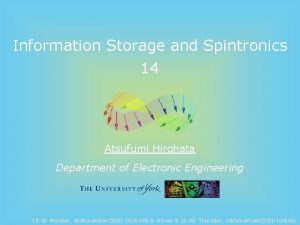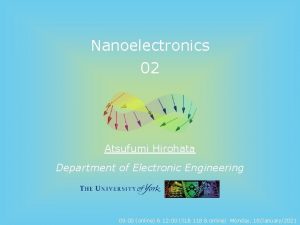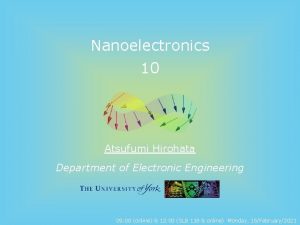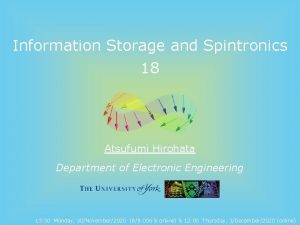Semiconductor Devices 21 Atsufumi Hirohata Department of Electronics
















![Typical Bandgaps between the conduction and valence bands : Bandgap Eg [e. V] Resistivity Typical Bandgaps between the conduction and valence bands : Bandgap Eg [e. V] Resistivity](https://slidetodoc.com/presentation_image_h/a573747ed12be229111d7b38f70de693/image-17.jpg)










- Slides: 27

Semiconductor Devices 21 Atsufumi Hirohata Department of Electronics 11: 00 Thursday, 20/November/2014 (P/T 005)

Contents of Semiconductor Devices Lectures : Atsufumi Hirohata (atsufumi. hirohata@york. ac. uk, P/Z 019) p-n junctions and Schottky diodes (Weeks 8 ~ 10) [11: 00 Mon. (P/L 005), Tue. (P/L 006) & Thu. (P/T 005)] 21. Intrinsic semiconductor 22. Extrinsic semiconductor 23. p-n junction 24. Bias application 25. Metal semiconductor junction 26. Schottky junction 27. Metal oxide semiconductor junction Lecture notes / slides : http: //www-users. york. ac. uk/~ah 566/lectures. html

What is semi-conductor ? Band diagrams : Allowed Forbidden Allowed metal conductors Forbidden Allowed semiconductors insulators With very small energy, electrons can overcome the forbidden band. EF

Energy Band of a semiconductor Schematic energy band diagram : E Conduction band conduction electron Band gap hole Valence band

Elemental Semiconductors In the periodic table, Carrier density : Cu (metal) ~ 10 23 cm -3 Ge (semiconductor) ~ 10 13 cm -3 Semimetal : conduction and valence bands are slightly overlaped. As (semimetal) ~ 10 20 cm -3 Sb (semimetal) ~ 10 19 cm -3 C (semimetal) ~ 10 18 cm -3 Bi (semimetal) ~ 10 17 cm -3

Si Substrate Manufacturing Czochralski process : Silicon is the second most common element in the Earth crust. A common form is Silicon dioxide, Si. O 2 (Silica). A Si single-crystal with a desired orientation is used. The Si crystal is lifted at a certain rotation speed from melt Si pot. * http: //www. allaboutcircuits. com/vol_3/chpt_2/12. html; ** http: //www. homepower. com/articles/solar-electricity/equipment-products/peek-inside-pv

Fabrication of a Si-Based Integrated Circuit Czochralski method : Si purity (99. 99999 %) * http: //www. wikipedia. org/

Compound Semiconductors In the periodic table, III-V compounds : Ga. As, In. Sb, Al. P, BP, . . . II-VI compounds : Zn. O, Cd. S, Cd. Te, . . . IV-IV compounds : Si. C, Ge. Si IV-VI compounds : Pb. Se, Pb. Te, Sn. Te, . . .

Semiconductor Band Gap in Si, Ge and Ga. As * M. P. Marder, Condensed Matter Physics (John-Wiley, New York, 2000).

21 Intrinsic Semiconductor • Bandgap Conduction band • Valence band • • Fermi level • Shockley Model • Carrier density • Ion implantation

Intrinsic Semiconductors Atomic structures : * http: //chemwiki. ucdavis. edu/u_Materials/Semiconductors/Intrinsic_Semiconductors

Shockley Model Contributions for electrical transport : E Conduction band Band gap conduction electron (number density : n) positive hole (number density : p) Valence band Ambipolar conduction Intrinsic semiconductor * http: //www. wikipedia. org/

Carrier Number Density of an Intrinsic Semiconductor Carrier number density is defined as Here, the Fermi distribution function is For the carriers like free electrons with m*, the density of states is For electrons with effective mass me*, g(E) in the conduction band is written with respect to the energy level EC, For holes with effective mass mp*, g(E) in the valence band is written with respect to the energy level EV = 0, * H. Ibach and H. Lüth, Solid-State Physics (Springer, Berlin, 2003).

Carrier Number Density of an Intrinsic Semiconductor (Cont'd) fp(E) for holes equals to the numbers of unoccupied states by electrons : n is an integral in the conduction band from the bottom EC to top Ect : p is an integral in the valence band from the bottom -EVb to top 0 : Here, EC (= Eg = EC - EV) >> k. BT E - EF EC /2 for EC E Ect (EF ~ EC /2) Similarly, EC >> k. BT -(E - EF) EC /2 for EVb E 0

Carrier Number Density of an Intrinsic Semiconductor (Cont'd) For E - EF > 3 k. BT, Similarly, As a result, and hence ECt ∞ and hence EVb -∞

Fermi Level of an Intrinsic Semiconductor For an intrinsic semiconductor, Assuming, me* = mp* = m* np product is calculated to be constant for small ni can be applied for an extrinsic (impurity) semiconductor
![Typical Bandgaps between the conduction and valence bands Bandgap Eg e V Resistivity Typical Bandgaps between the conduction and valence bands : Bandgap Eg [e. V] Resistivity](https://slidetodoc.com/presentation_image_h/a573747ed12be229111d7b38f70de693/image-17.jpg)
Typical Bandgaps between the conduction and valence bands : Bandgap Eg [e. V] Resistivity r [W cm] Ge 0. 66 0. 5 Si 1. 11 2. 3 × 103 Ga. As 1. 43 ~ 103 C (diamond) 6~7 × 1012 Eg ∝ r Semiconductors : Eg ~ 0. 1 ~3. 0 e. V

Typical Bandgaps between the conduction and valence bands : Vacuum level Electron affinity Work function Ionisation energy Electron / hole transport under a bias : http: //kccn. konan-u. ac. jp/physics/semiconductor/diagram/a 05. html * http: //fhirose. yz. yamagata-u. ac. jp/text/kiso 1. pdf

Intrinsic Semiconductors Band structures : Energy Some electrons Some holes Probability * http: //hooktail. sub. jp/solid/shino-PNI-type. Semiconductor-upper/

Extrinsic Semiconductors p-type band structures : n-type band structures : * http: //hooktail. sub. jp/solid/shino-PNI-type. Semiconductor-upper/

Fabrication of Doped Semiconductor Ion implantation : Typical acceleration energy : 10 ~ 500 ke. V. Annealing required to activate injected ions as donors / acceptors. * http: //www. wikipedia. org/

Fabrication of p-n Junctions 1 Alloy type or fused junction diodes : * http: //www. circuitstoday. com/semiconductor-diode-fabrication-types

Fabrication of p-n Junctions 2 Diffused junction diodes : * http: //www. circuitstoday. com/semiconductor-diode-fabrication-types

Fabrication of p-n Junctions 3 Epitaxial growth or planar diffused diodes : epi = upon + taxis = arrangement. * http: //www. circuitstoday. com/semiconductor-diode-fabrication-types; ** http: //www. allaboutcircuits. com/vol_3/chpt_2/12. html

Fabrication of p-n Junctions 4 Point contact diodes : Bonded by radio frequency heating. * http: //www. circuitstoday. com/semiconductor-diode-fabrication-types

Intrinsic Semiconductors Band structures : EC EV NV and NC : carrier densities of the valence and conduction bands Fermi level : (ni : intrinsic carrier density) * http: //chemwiki. ucdavis. edu/u_Materials/Semiconductors/Intrinsic_Semiconductors

Exercise 1 Find the probability of occupation of a level of 0. 05 e. V above the conduction band edge of a Silicon device if the Fermi level is 0. 7 e. V above the valence band edge. Assume the bandgap (Eg) of Silicon is 1. 1 e. V and the effective mass of electron in Silicon is 0. 40 (0. 91 10 -30 kg). The Boltzmann constant (k. B) is 1. 4 10 -23 J/K, the Planck constant is 6. 6 10 -34 J s and the temperature is 300 K. Use the conversion ratio: 1 e. V = 1. 6 10 -19 J.
 Atsufumi hirohata
Atsufumi hirohata Atsufumi hirohata
Atsufumi hirohata Atsufumi hirohata
Atsufumi hirohata Atsufumi hirohata
Atsufumi hirohata Atsufumi hirohata
Atsufumi hirohata Atsufumi hirohata
Atsufumi hirohata Fermi velocity
Fermi velocity Difference between ram and rom in digital electronics
Difference between ram and rom in digital electronics Electronics and information technology department odisha
Electronics and information technology department odisha Department of electronics & information technology
Department of electronics & information technology Special semiconductor devices
Special semiconductor devices Classification of power semiconductor devices
Classification of power semiconductor devices Johanna müting
Johanna müting Power semiconductor devices lecture notes
Power semiconductor devices lecture notes Semiconductor devices
Semiconductor devices Fundamentals of semiconductor devices anderson solution
Fundamentals of semiconductor devices anderson solution Semiconductor junction devices
Semiconductor junction devices Power electronics circuits devices and applications
Power electronics circuits devices and applications Electronics fundamentals circuits devices and applications
Electronics fundamentals circuits devices and applications Literary elements/devices
Literary elements/devices Input devices of computer
Input devices of computer Semiconductor
Semiconductor Pfc semiconductor
Pfc semiconductor Poisson's equation
Poisson's equation Compound semiconductor magazine
Compound semiconductor magazine Carrier concentration in intrinsic semiconductor
Carrier concentration in intrinsic semiconductor Short wave vs long wave radiation
Short wave vs long wave radiation Semiconductor
Semiconductor

